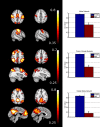Functional Connectivity in MRI Is Driven by Spontaneous BOLD Events
- PMID: 25922945
- PMCID: PMC4429612
- DOI: 10.1371/journal.pone.0124577
Functional Connectivity in MRI Is Driven by Spontaneous BOLD Events
Abstract
Functional brain signals are frequently decomposed into a relatively small set of large scale, distributed cortical networks that are associated with different cognitive functions. It is generally assumed that the connectivity of these networks is static in time and constant over the whole network, although there is increasing evidence that this view is too simplistic. This work proposes novel techniques to investigate the contribution of spontaneous BOLD events to the temporal dynamics of functional connectivity as assessed by ultra-high field functional magnetic resonance imaging (fMRI). The results show that: 1) spontaneous events in recognised brain networks contribute significantly to network connectivity estimates; 2) these spontaneous events do not necessarily involve whole networks or nodes, but clusters of voxels which act in concert, forming transiently synchronising sub-networks and 3) a task can significantly alter the number of localised spontaneous events that are detected within a single network. These findings support the notion that spontaneous events are the main driver of the large scale networks that are commonly detected by seed-based correlation and ICA. Furthermore, we found that large scale networks are manifestations of smaller, transiently synchronising sub-networks acting dynamically in concert, corresponding to spontaneous events, and which do not necessarily involve all voxels within the network nodes oscillating in unison.
Conflict of interest statement
Figures





References
-
- Biswal B, Yetkin FZ, Haughton VM, Hyde JS. Functional Connectivity in the Motor Cortex of Resting Human Brain Using Echo-Planar MRI. Magn Reson Med. 1995; 537–541. - PubMed
-
- Münchau A, Bloem BR, Irlbacher K, Trimble MR, Rothwell JC. Functional connectivity of human premotor and motor cortex explored with repetitive transcranial magnetic stimulation. J Neurosci. 2002;22: 554–61. Available: http://www.ncbi.nlm.nih.gov/pubmed/11784802 - PMC - PubMed
Publication types
MeSH terms
Substances
Grants and funding
LinkOut - more resources
Full Text Sources
Other Literature Sources
Medical
Miscellaneous

